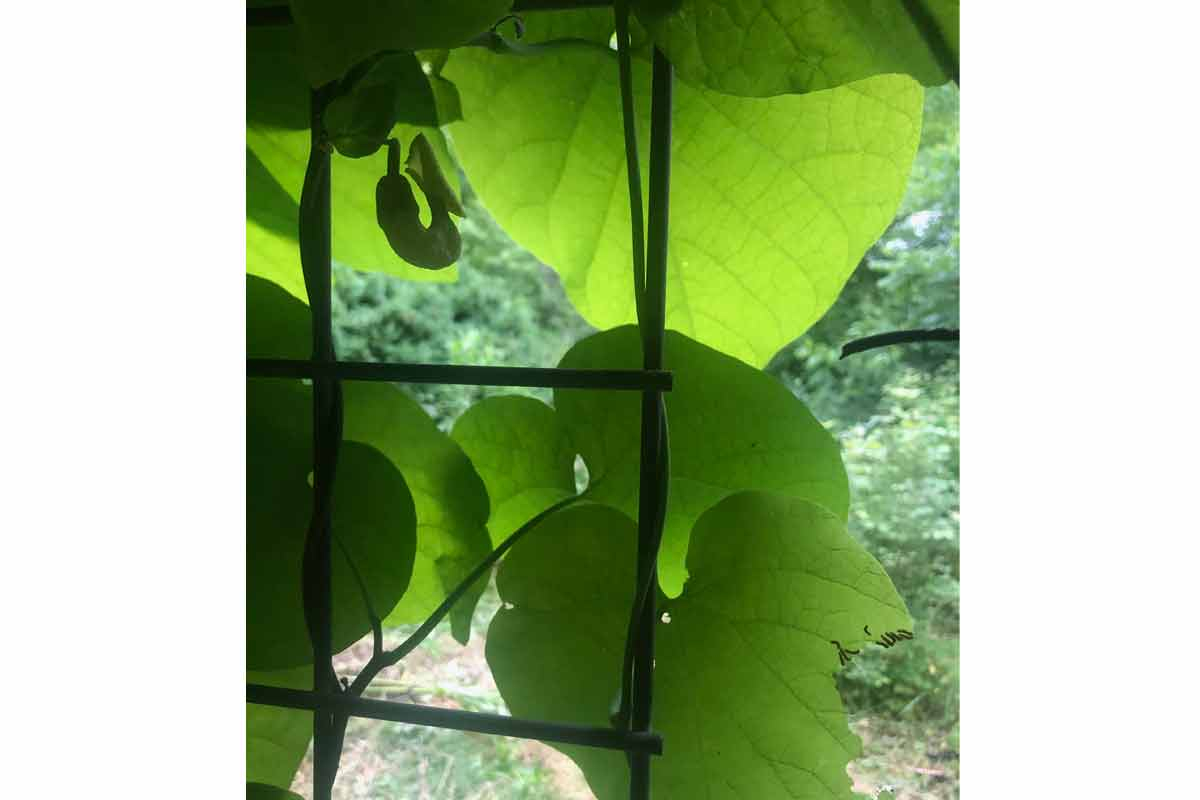Notes from a plant nerd: Put that in your pipe, but don’t smoke it
 A pipevine leaf bears the telltale bite marks of the pipevine swallowtail caterpillar. Adam Bigelow photo
A pipevine leaf bears the telltale bite marks of the pipevine swallowtail caterpillar. Adam Bigelow photo
Plants and butterflies have a long history of evolution and interconnected relationships. Plants serve as food for caterpillars who eat their leaves to gain energy for their growth and transformations. This co-evolved host-plant relationship mostly occurs between native plants and native caterpillars. Many butterflies depend on this relationship for their lives.
Here’s how it works: plants “eat” sunlight, transforming solar energy into sugar and carbohydrates through the process of photosynthesis. Insects, especially caterpillars of moths and butterflies (Lepidoptera) then eat the plant leaves. This is the main way solar energy is moved up and into the ecosystem and food web. Exotic plants — i.e. those that did not evolve in a region, grew up somewhere else — do not participate in this relationship as most native butterflies will not recognize exotic plants as a good and safe place to lay their eggs.
This is one of the reasons I, and so many other people and organizations are promoting the use of native plants in your landscape. Caterpillars eat the leaves of native plants, then birds and other animals eat many of those caterpillars and feed their young on them. Then those critters are eaten by other critters, who are consumed in turn by others, and finally the bacteria, fungi and other soil micro-organisms consume the waste. All of these organisms are interconnected in the food web. It’s the circle of life.
One of the most fascinating of these interconnected host plant relationships is that of the pipevine swallowtail butterfly (Battus philenor) and the Dutchman’s pipe, aka pipevine (Isotrema macrophyllum). The Dutchman’s pipe plant is loaded with a toxic chemical that keeps insects from eating its leaves. Most insects would die if they tried to dine on a pipevine leaf. But not only can the caterpillars of the pipevine swallowtail butterfly eat the leaves, it is one of only two plants in southern Appalachia that they can eat. The other is a plant called Virginia snakeroot (Endodeca serpentaria).
Dutchman’s pipe is a woody vine with large, heart-shaped leaves. It is known as pipevine because its flower is shaped similar to a meerschaum pipe, the curved type of pipe that Sherlock Holmes smoked. Pipevine flowers are green with a mottled red center that is trying to resemble the appearance of a dead animal. And the flowers emit a scent that smells like rotting meat. All of this is because they are trying to attract flies, their main pollinating insects, who think they are going to get a meal, and are instead tricked into pollinating the flowers.
Mountain folk call Dutchman’s pipe porchvine, as they liked to plant it on the sunny side of a porch to provide shade in the afternoon. When I learned of this, I got excited and thought, “I want porchvine growing up the side of my porch.” So, I went and bought one from a reputable and ethical plant nursery, so that I could be sure that they weren’t just dug from the woods, and I planted one on the southwestern corner of my porch. It grows there to this day.
Related Items
I enjoy telling this story when I give talks at garden clubs. Everything is happy and fine until I get to this part of the story. See, that first year I planted the Dutchman’s pipe these insects came and ate it all the way to the ground. This is when I often hear a collective sigh of “oh no” as I tell of the plant being consumed by insects. I wait a bit for emphasis, and then respond with an enthusiastic “oh yeah!”
Because the only insects those could have been are the caterpillars of the pipevine swallowtail butterfly. And that is why I planted it. One of the reasons anyway. To support pipevine swallowtail butterflies. The plant recovered just fine that first year. The next year it was only eaten 3/4ths of the way down. By year 4 you’d hardly notice the leaf damage, and it began flowering. Now, it grows lushly on my front porch, casting shade with its big, green, heart-shaped leaves and blooming profusely.
I now get to sit and take my morning coffee on the porch observing the flowers, watching pipevine swallowtail butterflies lay their eggs on the leaves. I get to see those eggs hatch into small caterpillars that grow progressively larger before crawling off to safety to go into their chrysalis and transform into an adult butterfly through metamorphosis. All while sipping coffee on my front porch, watching the circle of life. It’s like “The Lion King” in my yard. And that is just one plant and one insect that co-evolved together long ago.
Most every plant in my landscape has co-evolved relationships like this that I get to watch. And you can too. All you need to do is plant native plants in your landscape to attract native insects. It’s simple. If you plant them, they will come.
(Adam Bigelow lives in Cullowhee and leads weekly wildflower walks most Fridays and offers consultations and private group tours through Bigelow's Botanical Excursions. This email address is being protected from spambots. You need JavaScript enabled to view it..)









